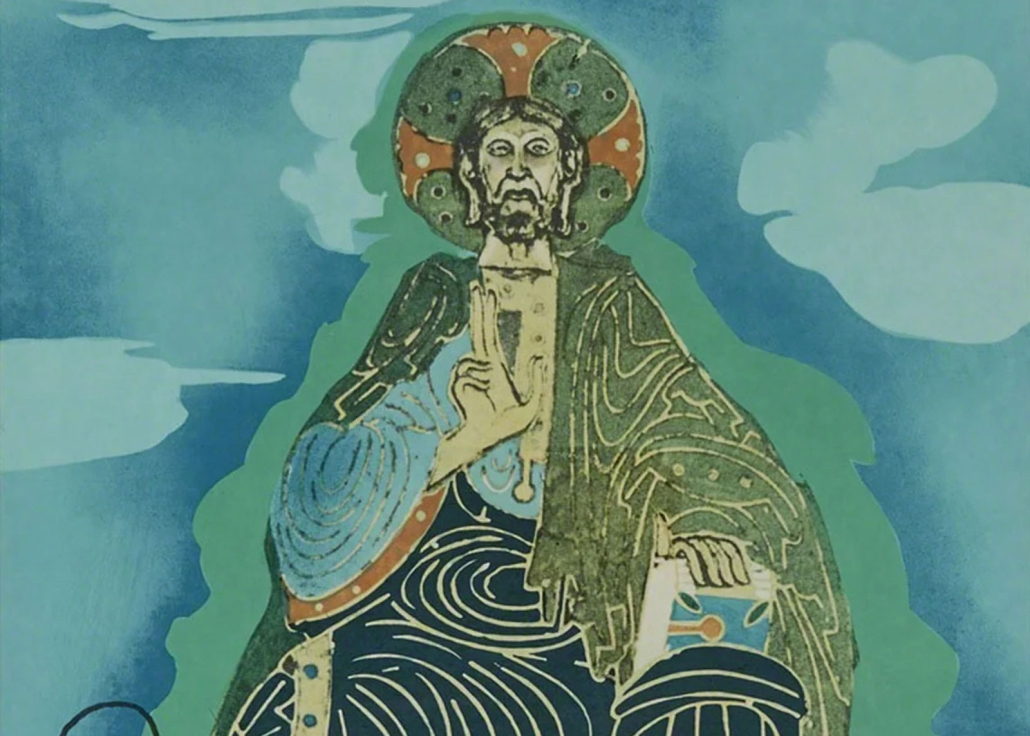Image: Salvador Dalí, Pantocrator – Christ In His Majesty (Tarot 3 of Coins), 1977. Colour lithograph and mezzotint of original gouache with collage and lithographic remarque (Torrents) on Japon paper.
‘The Most High, the Most Low’
Andrew Collis
Reign of Christ, Year B
Psalm 93; Revelation 1:4b-8; John 18:33-37
Is revelation always ironic, always subversive?
Our theme for today is certainly both ironic and subversive.
Again and again, biblical references to God as Most High (Psalm 93 is one example) meet biblical references to God as Most Low – the sacred revealed in and through the elements, in and through a pilgrim people, an enslaved people, younger sons and foreign daughters, poet-prophets and outsiders, stranger-angels, a shepherd-king, a servant-messiah, the hungry and thirsty, the sick and imprisoned, the naked and cold, the lost, last and least likely.
The sign on the cross … “It was to make fun of [Christ Jesus], of his reign. And even now the enemies of the kingdom go on making fun of the kingdom and of people that are struggling for it …” (Ernesto Cardenal).
The meaning? The invitation? To enter a realm of the sacred – creation itself as the kin(g)dom of God – by way of loving risk, by way of loving acceptance, by way of loving adventure, by way of Christ-like loving.
A familiar text from Matthew 25 (the parable of the sheep and the goats) is one of many reminders that Jesus aligns himself with those who cry: “I am hungry … I am stuck … I am lonely … I am caged … I am estranged, dispossessed … I am tired … I am struggling to find hope and meaning … I am dry … I am scared …” “Where are you?” Christ Jesus says.
Faith, primary faith – perhaps it’s even pre-faith – operates at this low level of call and response. Whatever “salvation” means, whatever “heaven on earth” means, has to do with epiphany and trauma – encounters with a holy other – compassion, connection, common ground, need, mercy, forgiveness …
I say epiphany and trauma because life can be overwhelmingly beautiful and painful. It is only on reflection that we move from pre-faith to faith, even theology …
At the theological level we may make a distinction between the sacred and the profane. At its best this can help us with liturgical practice and spiritual formation. At its worst it’s sectarianism – our books, buildings and rituals are sacred while society itself (frequently matter, culture, bodies, politics …) is profane – irreverent.
Jesus humiliated – arrested, accused of blasphemy, ridiculed as a joke-king, stripped, whipped and crucified – draws us again to epiphany and trauma – his, our own – inviting love, commanding love, insisting on it … addressed, as it were, by his voice alone – voicing our very own desires, calling us (as Mary Magdalene is called) by name.
The Franciscan writer Richard Rohr says the real distinction is not between the sacred and the profane but the sacred and the desecrated – and that we are the ones who do the desecrating; we are the ones who desacralise what is intrinsically sacred in all living beings.
How? By “refusing the call of the stranger to change what is …”
We confess that Christ/a is king/queen/ruler of all – that in and through the stranger, Jesus calls for food, freedom, forgiveness, hospitality, justice, rest – yes, and acknowledgement of sovereignty, that is, respect for wisdom and kinship, connection to land and waters, language and lore.
What we mean by the reign of Christ/a is a rule of love, unlike the rule of fundamentalists, tyrants; unlike the rule of intimidation and violence. Above all, love.
We mean that in Christ/a we discern another world – or, better, that in Christ/a we discern this world in a different light. We see creation as the kin(g)dom of God – as good, as beloved, as wounded/despoiled, as destined for wholeness.
When we say that Christ/a is a king/queen/ruler, we are challenging all those who rule – and we are challenging all violent and coercive government, all violent and coercive organisational structures (especially those of the churches) – in the Spirit of One who loves, who serves, at enormous cost to him- or herself.
When we say that Christ/a is king/queen/pantocrator, we picture Jesus enthroned on the cross and wearing a crown of thorns. Epiphany. Trauma. Irony. Subversion.
This is the high calling of God in Christ Jesus. At our most faithful, at our most human (in praise of the Most High, Most Low) we show forth in our life together this same courage, the same solidarity with all the victims of violence and abuse, the same prayerful openness to forgiveness and nonviolent love.
And “even those who pierced Jesus, and all the peoples of the earth will mourn over Christ. So be it! Amen” (Revelation 1:7b).




